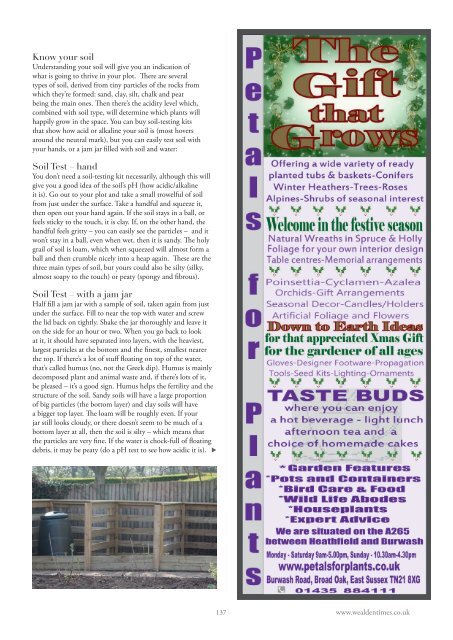Wealden Times | WT166 | December 2015 | Interiors supplement inside
Wealden Times - The lifestyle magazine for the Weald
Wealden Times - The lifestyle magazine for the Weald
You also want an ePaper? Increase the reach of your titles
YUMPU automatically turns print PDFs into web optimized ePapers that Google loves.
Know your soil<br />
Understanding your soil will give you an indication of<br />
what is going to thrive in your plot. There are several<br />
types of soil, derived from tiny particles of the rocks from<br />
which they’re formed: sand, clay, silt, chalk and peat<br />
being the main ones. Then there’s the acidity level which,<br />
combined with soil type, will determine which plants will<br />
happily grow in the space. You can buy soil-testing kits<br />
that show how acid or alkaline your soil is (most hovers<br />
around the neutral mark), but you can easily test soil with<br />
your hands, or a jam jar filled with soil and water:<br />
Soil Test – hand<br />
You don’t need a soil-testing kit necessarily, although this will<br />
give you a good idea of the soil’s pH (how acidic/alkaline<br />
it is). Go out to your plot and take a small trowelful of soil<br />
from just under the surface. Take a handful and squeeze it,<br />
then open out your hand again. If the soil stays in a ball, or<br />
feels sticky to the touch, it is clay. If, on the other hand, the<br />
handful feels gritty – you can easily see the particles – and it<br />
won’t stay in a ball, even when wet, then it is sandy. The holy<br />
grail of soil is loam, which when squeezed will almost form a<br />
ball and then crumble nicely into a heap again. These are the<br />
three main types of soil, but yours could also be silty (silky,<br />
almost soapy to the touch) or peaty (spongy and fibrous).<br />
Soil Test – with a jam jar<br />
Half fill a jam jar with a sample of soil, taken again from just<br />
under the surface. Fill to near the top with water and screw<br />
the lid back on tightly. Shake the jar thoroughly and leave it<br />
on the side for an hour or two. When you go back to look<br />
at it, it should have separated into layers, with the heaviest,<br />
largest particles at the bottom and the finest, smallest nearer<br />
the top. If there’s a lot of stuff floating on top of the water,<br />
that’s called humus (no, not the Greek dip). Humus is mainly<br />
decomposed plant and animal waste and, if there’s lots of it,<br />
be pleased – it’s a good sign. Humus helps the fertility and the<br />
structure of the soil. Sandy soils will have a large proportion<br />
of big particles (the bottom layer) and clay soils will have<br />
a bigger top layer. The loam will be roughly even. If your<br />
jar still looks cloudy, or there doesn’t seem to be much of a<br />
bottom layer at all, then the soil is silty – which means that<br />
the particles are very fine. If the water is chock-full of floating<br />
debris, it may be peaty (do a pH test to see how acidic it is). <br />
137 www.wealdentimes.co.uk<br />
PetalsForPlants<strong>WT166</strong>.indd 1 10/11/<strong>2015</strong> 10:01


















